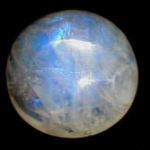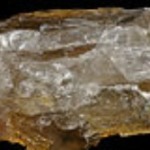Moonstone was named for it’s resemblance to the moon due to it’s shimmering effect or sheen. It is a variety of Orthoclase Feldspar. The shimmering is also found on Opal.This effect causes the stone to display a circular ghost-like reflection, with a bluish-whitish colour emanating from the surface when cut into a cabochon. This is caused by structural damage or build up of water in the mineral.
One myth around the name is very interesting. It is said you can observe the whole lunar month within the stone. As the new moon begins, a small white spot appears at the edge of the stone and slowly moves toward the stone’s center growing larger until it is the shape of the full moon in the center of the stone. Wow!
Sometimes moonstones reflect thin chasms of light similar to “cat’s eye” or or a star image when exposed to light. The stone comes in a variety of colors but most common is whitish blue. They also are known by several names such as Water Opal, Ceylonese Opal, Fish-eye and Wolf’s -eye. Long ago Greeks called the stone “Aphroselene” after the Goddesses Aphrodite (love) and Selene (moon)
The highest quality moonstones come from Sri Lanka. Other countries producing moonstones are Germany, Burma, India , tanzania, Brazil, Us and Mexico.
This gemstone has many interesting myths regarding it’s birth. Ancient Romans believed it was formed by moonlight. In the far East they believed the stones were actual moonlight rays that had solidified and and a good spirit lived within the stone. People in ancient India thought along similar lines.
It has been used to ensure aboundant crops. The stone is associated with love and fidelity and if held in the mouth it is supposed to help one make proper decisions.. It could cure insomnia and is the protector of sailors and night travelers. Moonstone was once called the “Traveler’s Stone”
It could also protect the mind from epilepsy, insanity and any problems of the mind.
Some say Moonstone can aid in opening the third eye Chakra and empowering your intuition. It is the gem of the High priestess, keeping the mysteries of femininity. Staring into a moonstone gemstone with reflected light,can reveal the missing peices of one’s life, in other words parts of your soul that has been forgotten. It can be used for deep meditation and works well with Ruby for added strength. Stimulates love, intuition,awareness, courage and passion. It is also known as the lover’s stone.
In India, the stone has always been sacred, where when displayed it is always set out on Saffron dyed cloth, the traditional color of India. Saffron itself is sacred and as a herbit is very expensive since it is not easy to grow. Saffron’s dyeing power is still used to give the golden yellow colour to cloth used for special purposes like Buddhist robes, the bride’s veil in some countries of Maghreb, such as Mauritania, Morocco, Algeria, Tunisia, and Libya. Today most of the world’s saffron is produced in Iran.
Sources: Wikipedia.com,
“The pocket Book of Stones” by Robert Simmons,
“Colored Gemstones” by Antoinette Matlins, P.G.
http://www.minerals.net/mineral/silicate/tecto/feldspar/variety/moonston.htm





